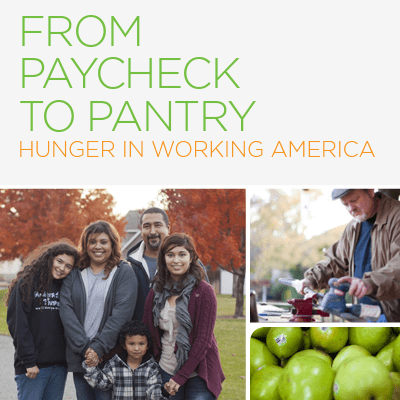From Paycheck to Pantry: Hunger in Working America
In 2014, Feeding America, in partnership with Oxfam America, published From Paycheck to Pantry: Hunger in Working America. The study uses data from the 2014 Hunger in America study to outline the common challenges households face in meeting basic needs, including limited hours on the job, changes in employment status, and competing household expenses.
- Nearly nine out of ten (89%) working households reported an annual household income of $30,000 or less.
- More than half (57%) of working client households reported part-time employment (30 hours or less per week).
- One in four (24%) working client households has an adult member currently enrolled in school. Though education may allow for more employment prospects or higher wages in the future, it can contribute to a temporary strain on household resources.
In Short Supply: American Families Struggle to Secure Everyday Essentials
In 2013, Feeding America, in partnership with the University of Illinois at Urbana-Champaign released In Short Supply: American Families Struggle to Secure Everyday Essentials. One in three low-income American families struggles to afford basic non-food household goods—including products related to personal care, household care, and baby care—and, as a result, make trade-offs with other living expenses and employ coping strategies to secure essential household goods. Over the last 12 months, families reported the following coping strategies and budget trade-offs i.e. 74% of families skipped washing dishes or doing laundry.
In Short Supply also found that more than 4 out of 5 families unable to afford basic necessities are also classified as food insecure, illustrating that struggling families have difficulty not only meeting their basic needs but their need for food as well.
Download the Executive Summary
Food Banks: Hunger's New Staple
After the Great Recession, households began using emergency food assistance programs as a consistent solution to their food needs.
In 2012, Feeding America, in partnership with Austin Community College, published Food Banks: Hunger’s New Staple. Drawing on data from Feeding America’s Hunger in America 2010 study, findings suggest that, in the aftermath of the Great Recession, families not only visit pantries for emergencies or temporary food needs – instead, for most people seeking food assistance, pantries became a part of households’ long-term strategies to supplement monthly food budget shortfalls. Seniors, who so often are limited by fixed or limited incomes, were among the most consistent pantry clients.

